
"Screen" might also refer to a fine grid or lattice, manufactured in many grades of mesh, in order to act like a filter or seive, separating material of various sizes by allowing passage of smaller particles, disallowing passage of larger particles.
Wire and plastic screens are commonly used in windows.
Sand can be sifted (refined) by passing it through screens in order to remove other materials, and to separate particles into various standard sizes, or to remove it from clay, etc.
Similarly, a screen can be used to remove debris from paints, solvents, and other liquids.
A screen typically forms the pulp-restraining surface of a deckle used in papermaking.
In printing, a glass plate marked off with crossing lines, placed before the lens of a camera when photographing for halftone reproduction. "Screen" can also refer to silkscreen printing — a process in which a screen supports all the components of a stencil, maintining their arrangement as inks pass through the screen.
Also, the white or silver surface onto which a picture is projected for viewing, or to show or project (a movie, for example) onto a screen.
By extension, because the face of a monitor is such a screen, any image of the full area of a monitor is called a screen image, or simply a screen.
Examples of screens in the first sense:
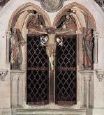
French, Choir screen with the Crucifixion at the Cathedral
at Naumburg, c. 1245, stone.
Inside a Gothic cathedral,
the nave was usually separated
from the choir by a large
stone choir screen, called a 'pulpitum' or 'jubé', which
excluded the lay public from the liturgy performed behind it.
The screens at Chartres and Amiens were later removed, but at
Naumburg a superbly carved
example from the middle of the thirteenth century has remained
intact.

India, Mughal;
found at/reportedly from Fatehpur Sikri, India, Jali
screen, one of a pair, second half of the 16th century,
carved red sandstone, 73
1/4 x 51 3/16 x 3 9/16 inches (186 x 130 x 9 cm), Metropolitan
Museum of Art, NY.
![]()
Attributed to Kano Sansetsu (Japanese, 1589/90-1651),
The Old Plum, Edo
period (1615-1868), c. 1645, four sliding door panels (fusuma),
ink, color,
and gold
leaf on paper,
height 68 3/4 inches (174.6 cm), width of one panel 45 11/16
inches (116 cm), width of all four panels 15 feet 11 1/8 inches
(485.3 cm), Metropolitan Museum of Art, NY. See Japanese art.
![]()
A Painter ot the Kano School, (Japanese,
active 1596-1614), Falcon on Oak Tree Watching Monkeys,
six-panel folding screen; ink and light color on paper; no signature; interpolated jar-shaped
kuninobu seal of Kano Eitoku (1543-90), Worcester Art Museum,
MA.
![]()
![]()
Anonymous Town Painter (Japanese, active
early 17th century), Willows by the Uji Bridge —
first and second of a pair of six-panel folding
screens; ink, color,
and gold on
paper, Worcester Art Museum, MA.
See Edo period.
![]()
![]()
Kano Naonobu (Japanese, 1607-50), Tiger, left and right of a pair of six-panel folding screens;
ink on paper;
signature: Naonobu hitsu; seal:
Fujiwara, Worcester Art Museum, MA.

Japan, The Battles of Hogen and Heiji, Edo
period (1615-1868), 17th century, pair of six-panel folding
screens, ink, color,
and gold
leaf on paper,
each 60 15/16 x 11 ft 8 inches (154.8 x 355.6 cm), Metropolitan
Museum of Art, NY. See bird's-eye
view and panorama.

Ogata Korin (Japanese, 1658-1716), Eight-Planked Bridge (Yatsuhashi), Edo period (1615-1868), 18th century,
pair of six-panel folding screens, ink,
color, and gold-leaf on paper,
Each 70 1/2 x 12 feet 2 1/4 inches (179.1 x 371.5 cm), Metropolitan
Museum of Art, NY.
![]()
![]()
Miyagawa Choshun (Japanese, 1682-1752), Pictures of Amuseuments at Cherry-Blossom-Viewing
Time, left
and right of a pair of six-panel folding screens,
Kyoho period (1716-36), ink, color, and gold on paper;
signature: Nihon e Miyagawa Choshun
zu (on each screen); seal:
Unidentified (left screen only), Worcester Art Museum, MA.
Watanabe Shiko (Japanese, Edo period, 1683-1755), Irises [detail], Cleveland Museum of Art.
![]()
Yosa Buson (Japanese, 1716-83), Travelers on Horseback on a Mountain in Spring,
1770s, four-panel folding screen; ink,
light colors, and gold
on paper; signature:
Shunseisha; seals: (upper)
Shachoko, (lower) Sha Shunsei, Worcester Art Museum, MA.

Nagasawa Rosetsu (Japanese, 1754-99), Bamboo, 1790s, six-panel folding screen;
ink on paper;
no signature; seals:
(upper) Nagasawa, (lower) Gyo, Worcester Art Museum, MA. See bamboo and nature.

Sakai Hoitsu (Japanese, 1761-1828), Cranes, two-panel folding screen; ink, colors, and gold on paper;
signature: Hoitsu Kishin hitsu;
seals: (upper) Oson, (lower)
Monsen, Worcester Art Museum, MA.
![]()
Yokoi Kinkoku (Japanese, 1761-1832), Landscape, after 1810, six-panel folding
screen; ink and light color on paper; signature:
Kinkoku; seal: Kinkoku,
Worcester Art Museum, MA.

Lockwood de Forest (American, 1850-1932),
designer; made in New York/Ahmedabad, America/India, Screen, 1881-1890, teak, plaited matting,
mixed metals, 65 x 69
3/4 x 1 3/4 inches (165.1 x 177.2 x 4.4 cm), Metropolitan Museum
of Art, NY.

Seraphin Soudbinine (French, 1870-1944),
designer, Jean Dunand (French, 1877-1942), designer, "Fortissimo" Screen, 1925-26,
lacquered wood; each panel:
98 x 35 inches (246.9 x 89.9 cm), Metropolitan Museum of Art,
NY. See Art
Deco.
Examples of a screen in the
last sense:
![]()
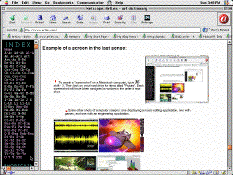
To create a "screenshot" on an
Apple computer, type
![]() -
shift - 3. Then look on your hard drive for files titled "Picture".
Each screenshot will have been assigned a number in the order
it was shot.
-
shift - 3. Then look on your hard drive for files titled "Picture".
Each screenshot will have been assigned a number in the order
it was shot.
Some other shots of computer screens:
one displaying a music editing application, two with games, and
one with an engineering application.
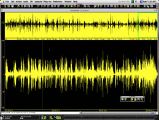
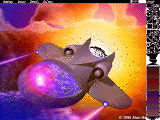
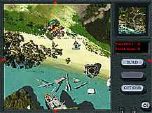
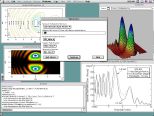
Also see Japanese art and panorama.
https://inform.quest/_art